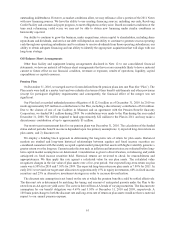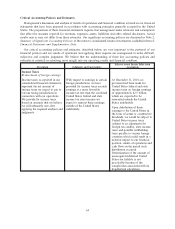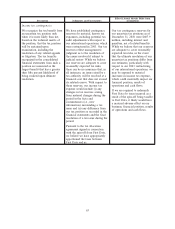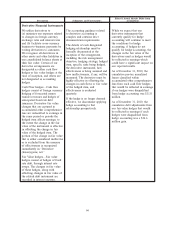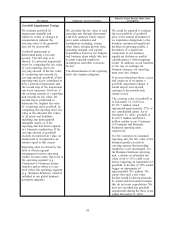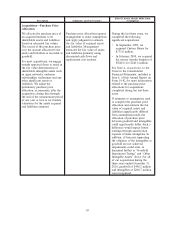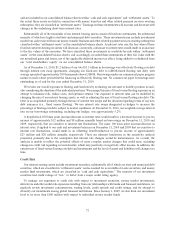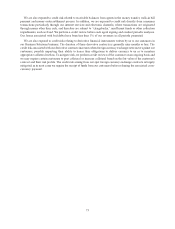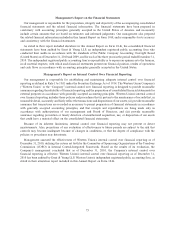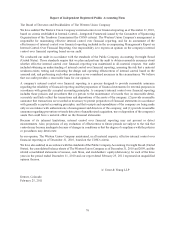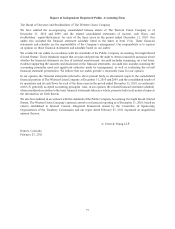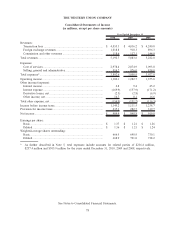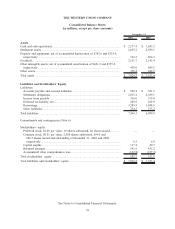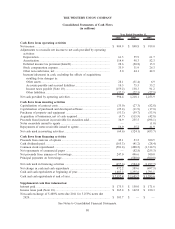Western Union 2010 Annual Report Download - page 73
Download and view the complete annual report
Please find page 73 of the 2010 Western Union annual report below. You can navigate through the pages in the report by either clicking on the pages listed below, or by using the keyword search tool below to find specific information within the annual report.ITEM 7A. QUANTITATIVE AND QUALITATIVE DISCLOSURES ABOUT MARKET RISK
We are exposed to market risks arising from changes in market rates and prices, including changes in foreign
currency exchange rates and interest rates and credit risk related to our agents and customers. A risk management
program is in place to manage these risks.
Foreign Currency Exchange Rates
We provide consumer-to-consumer money transfer services in 200 countries and territories. We manage foreign
exchange risk through the structure of the business and an active risk management process. We settle with the vast
majority of our agents in United States dollars or euros. However, in certain circumstances, we settle in other
currencies. We typically require the agent to obtain local currency to pay recipients; thus, we generally are not
reliant on international currency markets to obtain and pay illiquid currencies. The foreign currency exposure that
does exist is limited by the fact that the majority of transactions are paid within 24 hours after they are initiated. To
mitigate this risk further, we enter into short-term foreign currency forward contracts, generally with maturities
from a few days up to one month, to offset foreign exchange rate fluctuations between transaction initiation and
settlement. We also utilize foreign currency forward contracts, typically with terms of less than one year at
inception, to offset foreign exchange rate fluctuations on certain foreign currency denominated cash positions and
intercompany loans. In certain consumer money transfer and global business payments transactions involving
different send and receive currencies, we generate revenue based on the difference between the exchange rate set by
us to the customer and the rate at which we or our agents are able to acquire currency, helping to provide protection
against currency fluctuations. We promptly buy and sell foreign currencies as necessary to cover our net payables
and receivables which are denominated in foreign currencies.
We use longer-term foreign currency forward contracts to mitigate risks associated with changes in foreign
currency exchange rates on consumer-to-consumer revenues denominated primarily in the euro, and to a lesser
degree the British pound, Canadian dollar and other currencies. We use contracts with maturities of up to 36 months
at inception to mitigate some of the impact that changes in foreign currency exchange rates could have on forecasted
revenues, with a targeted weighted-average maturity of approximately one year. We believe the use of longer-term
foreign currency forward contracts provides predictability of future cash flows from our international
consumer-to-consumer operations.
With the acquisition of Custom House in the third quarter of 2009, our foreign exchange risk and associated
foreign exchange risk management has increased due to the nature of this business. The significant majority of
Custom House’s revenue, now known as Western Union Business Solutions (“Business Solutions”), is from
exchanges of currency at the spot rate enabling customers to make cross-currency payments. This business also
writes foreign currency forward and option contracts for our customers to facilitate future payments. The duration
of these derivatives contracts is generally nine months or less. Our Business Solutions business aggregates its
foreign exchange exposures arising from customer contracts, including the derivative contracts described above,
and hedges the resulting net currency risks by entering into offsetting contracts with established financial institution
counterparties. The foreign exchange risk is actively managed.
At December 31, 2010 and 2009, a hypothetical uniform 10% strengthening or weakening in the value of the
United States dollar relative to all other currencies in which our profits are generated would have resulted in a
decrease/increase to pre-tax annual income of approximately $32 million and $27 million, respectively, based on
our forecast of unhedged exposure to foreign currency at those dates. There are inherent limitations in this
sensitivity analysis, primarily due to the assumption that foreign exchange rate movements are linear and
instantaneous, that the unhedged exposure is static, and that we would not hedge any additional exposure. As a
result, the analysis is unable to reflect the potential effects of more complex market changes that could arise, which
may positively or negatively affect income.
Interest Rates
We invest in several types of interest bearing assets, with a total value at December 31, 2010 of $3.3 billion.
Approximately $2.5 billion of these assets bear interest at floating rates and are therefore sensitive to changes in
interest rates. These assets primarily include money market funds and state and municipal variable rate securities
71


